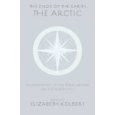Cold Comfort

Few things make a child rue global warming more than a snow-day-free winter. Half way through January with not a flake in sight, my kids are beginning to despair. In contrast, I can recall winters when nor’easters brought days-long ice storms and the consequent school reprieve as late as March. Memory, in this case at least, gives me hope.
But hope doesn’t make me wish less ardently for a blizzard. Instead of staring fruitlessly at Weather.com, I turned for solace to a new volume, The Ends of the Earth: An Anthology of the Finest Writing on the Arctic and the Antarctic. Inspired by the 2007-2008 International Polar Year, which aims at heightening awareness and encouraging research, the work presents writings from the earliest days of polar exploration to the present. The wages of snow obsession, as should forewarn my kids, are abundantly clear in many of the selections. Here’s this from Nobu Shirashe, who returned from a Japanese Antarctic Expedition in 1912:
The whole enterprise was indescribably difficult and fraught with danger, and it was without doubt the worst of the trials and tribulations we have experienced since we left our mothers’ wombs.
The withering monotony of the endless polar night is captured by Fridtjof Nansen, on board a ship helplessly adrift in the Arctic ice:
One day differed very little from another on board, and the description of one is, in every particular of any importance, a description of all.
And from Robert Peary, who may or may not have exaggerated his claims to have reached the North Pole in 1909:
If it were possible for a man to arrive at 90 degrees north latitude without being utterly exhausted, body and brain, he would doubtless enjoy a series of unique sensations and reflections. But the attainment of the Pole was the culmination of days and weeks of forced marches, physical discomfort, insufficient sleep, and racking anxiety. It is a wise provision of nature that the human consciousness can grasp only such degree of intense feeling as the brain can endure, and the grim guardians of earth’s remotest spot will accept no man as guest until he has been tried and tested by the severest ordeal.
Some may quibble that the volume is over-stuffed with such tales of early explorers’ machismo. Indeed, from the relative security of his well-stocked ship, Nansen laments, “I am almost ashamed of the life we lead, with none of those darkly painted sufferings of the long winter night which are indispensable to a properly exciting Arctic expedition. We shall have nothing to write about when we get home.” But looking deeper into the book, I found plenty of variety beyond the standard explorers’ memoirs and logs. Fictional offerings include works by Jules Verne, Jack London, and Andrea Barrett, and expository nature essays appear from Gretel Erhlich, Barry Lopez, and other contemporary masters. Lopez’s essay from his 1985 Pulitzer Prize winning Arctic Dreams in particular gains fresh relevance when read in this context, as he relishes the movements of caribou and snow geese from the perspective of a man not near starvation, as well as extolling immutable rhythms of animals in wild nature in a time before acute awareness of climate change. 
Given the ever-more alarming news of shrinking ice sheets and vanishing polar bears and penguins, it may also surprise readers that only a few of authors explore how global warming is impacting the earth’s extremes. Co-editor Elizabeth Kolbert, author of a galvanizing climate change report, Field Notes from a Catastrophe, addresses such concerns briefly but grimly in her introduction, admitting, “A landscape that once symbolized the sublime indifference of nature will, for future generations, come to symbolize its tragic vulnerability.” But I, for one reader, am pleased that the vast majority of the book offers a pure white escape. This warm winter, I found in it a place to refresh my winter memories and, perhaps, to learn how to proceed bravely instead of hunkering down in the cold and dark.





No comments:
Post a Comment